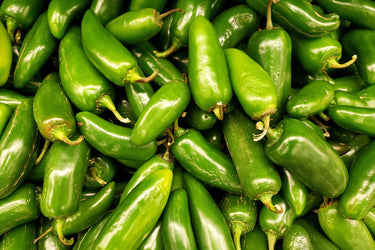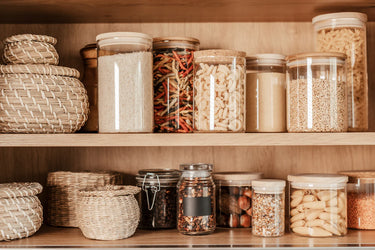How To Get Jalapeño Off Your Hands: An Anti-Capsaicin Guide

When it comes to cooking, many home chefs turn up the heat a little from time to time. But as much as we love a kick of spice from our favorite peppers, we aren’t trying to take them with us after dinner.
We’ve all been there. We cut a few hot peppers for our fresh guac or to spice up a salsa. We slice, dice, and then rinse off our hands and go about our business. Our eye itches, we rub it, and then BAM! Cut to burning and intense pain that makes us feel like we’ve gone blind.
So what do we do? Thankfully, HexClad has the answers. Believe it or not, burning hands as a result of peppers like jalapeños is a common occurrence. We have tips and tricks at the ready to help you make the burn subside. We will also explain what capsaicin is and why it brings the burn, plus answer a couple of commonly asked questions. Dry those eyes; relief is on the way.
Why Does Jalapeño Linger on Your Hands?
Depending on the type of pepper and level of capsaicin, there’s a chance you may have a burning sensation on your hands that feels like it came out of nowhere, and it won’t go away. This sensation is nicknamed “jalapeño hands” since jalapeños are one of the most commonly used peppers.
You’re probably asking yourself, “why me??” But don’t feel too bad; it’s not just you. Jalapeño peppers and other hot peppers will linger on your hands and cause a burning sensation. Your hands will burn and tingle for a while, and that pain can easily be transferred to any sensitive area on your body if you’re not careful.
But how exactly is this happening? And why, if the burn on your tongue is gone, does it feel like the devil just kissed your hands?
Before we can tell you how to alleviate the burn, we have to tell you what’s causing it: capsaicin. We are going to break down what capsaicin is, why it’s causing that burning sensation on your hands, and where you can expect to find it.
Capsaicin Explained
Capsaicin is the compound in various chili peppers that makes them spicy. This chemical is found in the fruit of any plant in the capsicum family, including:
- Bell peppers
- Cayenne
- Paprika
- Jalapeños
The list goes on to include all chili peppers. This means that even though capsaicin molecules make chili peppers spicy, it doesn’t necessarily mean that every fruit containing it will be spicy. Different peppers have various amounts of this capsaicin (we’ll get to that more in a minute).
While you may already know about capsaicin's ability to bring the heat, this chemical also brings a lot of health benefits to the table.
Nutritionally, capsaicin is rich in vitamins and minerals, keeping it at the forefront of cooking for over 700 years. In addition, capsaicin is believed to have beneficial antimicrobial qualities.
Medically, capsaicin is used in a lot of creams, ointments, and gels for pain relief. Specifically, capsaicin triggers reactions from the TRPV1 receptor channel. These receptors are located throughout the body and can be found in places like the brain, peripheral nerves, blood vessels, and bladder.
The TRPV1 channels are also known as capsaicin channels and can react to heat, pain, inflammation, and reactions from the body. Due to the anti-inflammatory qualities of capsaicin, it is a great agent in a heart-healthy diet and can help lower the risk of heart disease in patients with good cholesterol levels.
Capsaicin could help to boost metabolism and may even aid in weight loss.
Which Peppers Have the Most Capsaicin?
Capsaicin is found in all peppers, not just spicy ones, though it will vary from one to the next. The basic rule here is this: the spicier the pepper, the more capsaicin you can expect to get from it.
You can get a sense of how much capsaicin you’re in for based on the Scoville rating associated with each specific pepper. The Scoville scale was created in 1912 by Wilbur Scoville, and it aims to measure the degree of strength or potency of capsaicin in a pepper.
Originally, this test was administered by hand using willing participants as guinea pigs. Chili oils were created from hot peppers, and test subjects would taste the jalapeño oil or other oils to determine how hot it was. A drop of water would be added each time it was tested until the testers could no longer feel the heat.
Today, Scoville heat units, or SHU, are determined by a scientific method known as high-performance liquid chromatography. This process measures the capsaicin in the chile pepper and uses these measurements to determine the Scoville rating.
There are eight total groupings on the Scoville scale, ranging from mild to extremely hot.
This list includes:
- Mild (0-2,000 SHU): Bell pepper, anaheim, poblano
- Mild hot (20,000-50,000 SHU): Jalapeño, serrano, cayenne
- Hot (50,000-100,000 SHU): Pequin, Thai chili peppers
- Spicy hot (100,000-250,000 SHU): Scotch bonnet, Jamaican hot yellow
- Very hot (250,000-500,000 SHU): Habanero, Devil’s tongue red
- Really hot (500,000-1 MIL SHU): Red Savina, 7 pot yellow
- Fiery hot (1 MIL-1.5 MIL SHU): 7 pot Lucy, Naga viper, Komodo dragon
- Extreme hot (1.5 MIL ++ SHU): Carolina reaper, ghost pepper, scorpion pepper
There are many more peppers than what you see here, but these ratings stay the same. If you come across a pepper that you’re unsure of, you can look up its Scoville rating and estimate how much pain you’re in for if you don’t wear latex gloves or other hand protection.
A fun fact about capsaicin: the TRPV1 receptors in the peripheral nerves will dull the more you’re exposed to the pepper. It may be painful, but eating hot peppers over and over again can help alleviate the pain and sting you feel the first few times you eat them.
Does Wearing Gloves While Cooking Stop the Sting?
Wearing gloves can help alleviate hot pepper hands, otherwise known as the sting acquired when cooking with peppers. If you ever watch cooking shows or food challenge shows where the contestants need to eat hot peppers or the spiciest wings, then you’ll see the chefs preparing the dishes with disposable gloves to avoid skin irritation.
Be sure to wear latex or rubber gloves to keep your hands safe from the spicy burn.
The fumes from capsaicin oil can be just as pungent. In fact, these fumes can burn your hands if you’re not careful. The strength of certain peppers can also cause your eyes to burn when you inhale the aromas, similar to the enzymes in onions that cause you to cry.
5 Easy Ways To Get Jalapeño Off Your Hands
If you’re a victim of jalapeño hands, don’t worry. We are here for you. Keep your hands away from your eyes and try these tips and tricks to get the burn to subside.
They may seem a little wild, but we aren’t pulling your leg. These methods might just work for you.
1. Rub Some Ice Cream on Your Hands (No Joke)
Coating your hands in ice cream or another dairy product can help ease the burn on your hands. Most dairy products contain a protein called casein. Milk is comprised of about 80 percent of this protein which gives milk its white color.
Casein breaks down the capsaicin that is causing the burn on your hands and in your mouth. So while you can rub dairy on your hands to eliminate the burn, you could also take a hearty swig to dull the spice on your tongue.
If you don’t have dairy-based ice cream on hand, you can try sour cream, whole milk, or even dairy-based yogurt to help relieve the burning sensation.
2. Scrub for 40 Seconds With Soap and Water
Sometimes all you need is a thorough hand washing, so try scrubbing your hands with warm water and hand soap or dish soap to alleviate the burn. Work up a really thick lather, and then rinse until you start to get some relief.
If this doesn’t work as well as you hoped, you can also try scrubbing your hands with a little baking soda and warm water to release more of the oils.
3. Do an Alcohol Rinse
Alcohol is strong enough to kill germs — and it can kill the capsaicin on your hands as well. This stands to reason as to why alcohol is the main ingredient in hand sanitizers and many cleaning solutions.
Work rubbing alcohol into your hands, and you should start to feel relief pretty quickly. Rinse off with hot water, and you might feel brand new (or at least feel less discomfort from the burning sensation).
4. Look to Lemons
While some home remedies suggest reaching for a mixture of bleach diluted with hot water, that’s not a move we’d recommend. Stick to something safe for the skin, like lemon juice.
Lemons are high in acidity, and those acids are strong enough to neutralize the compounds in capsaicin. A fresh-squeezed lemon will work the best. Chop the lemon in half and squeeze out all the juice you can into a shallow bowl. Apply as needed.
5. Grab the Aloe Vera
The healing qualities of aloe vera aren’t just for sunburns. Aloe vera, olive oil, coconut oil, or vegetable oil can help neutralize the burning effect of capsaicin. The compounds in these oils or lotions have stronger effects on capsaicin compared to water. This can be a highly effective option.
Rub into your hands like lotion, regardless of the product you choose, and let it do its magic.
Make Your Best Spicy Dishes — Without Burning Your Hands
Chopped jalapeños for salsas or thin julienned pieces for a slaw are the perfect way to turn up the heat on classic dishes. Traditional dishes like this coconut curry dish are delicious, savory, and sweet, but adding an extra kick of spice will add to the palette perfectly, rounding out the flavor and leaving nothing to be desired.
So strap on a pair of rubber gloves, and make your guests cry. Happy tears, of course. If there’s anything we know here at HexClad, it’s that Gordon Ramsay can bring the heat. We want you to feel confident heating things up with peppers as well.
Whether you like to experiment with your own hot sauce, crank up the heat to create spicy foods and dishes, or want to have chili oil on hand as a finishing sauce, jalapeños bring the heat and flavor to any dish they’re added to.
But jalapeño hands are no laughing matter. Remember to put on latex or rubber gloves before chopping to keep you from experiencing the dreaded hand burn. Always wear gloves. If it’s too late and you’ve already begun to feel the burn, don’t panic. We are confident that these five tips and tricks will help you get your hands back to normal in no time.
Sources:
Inflammation, Cancer, and Immunity: Implication of TRPV1 Channel | FrontiersIN





